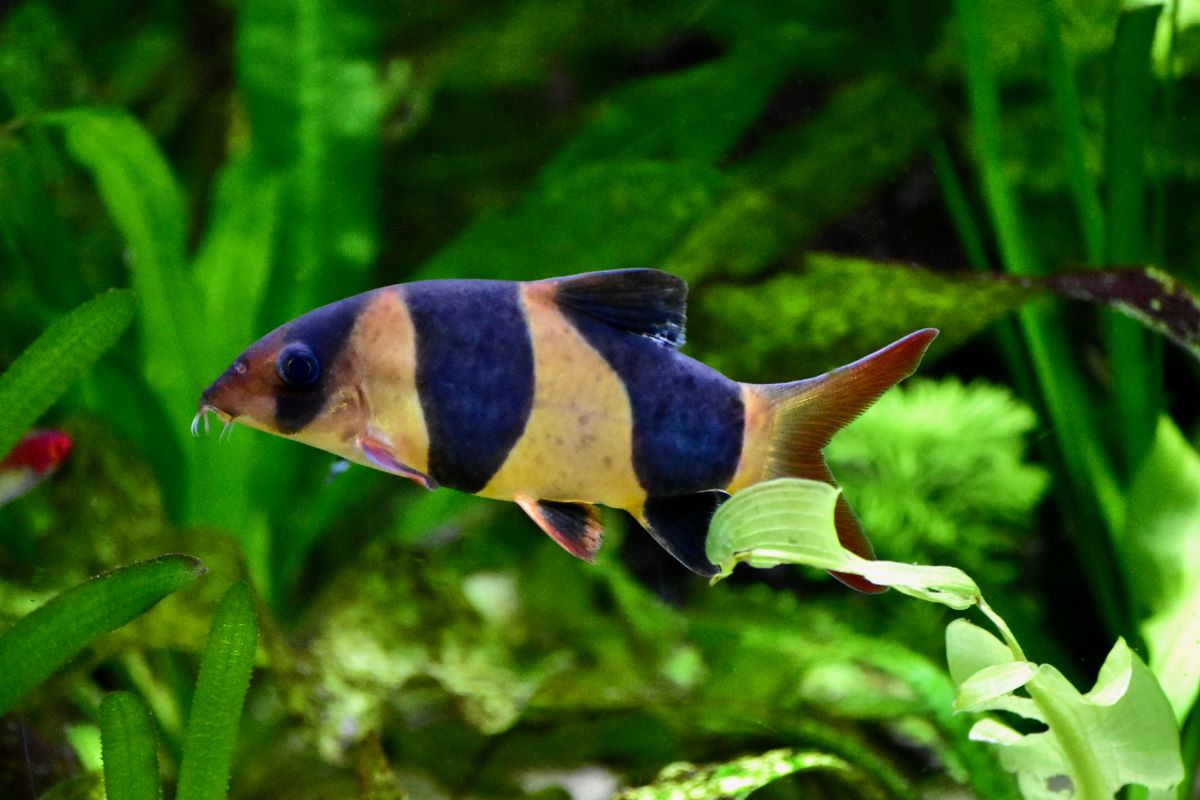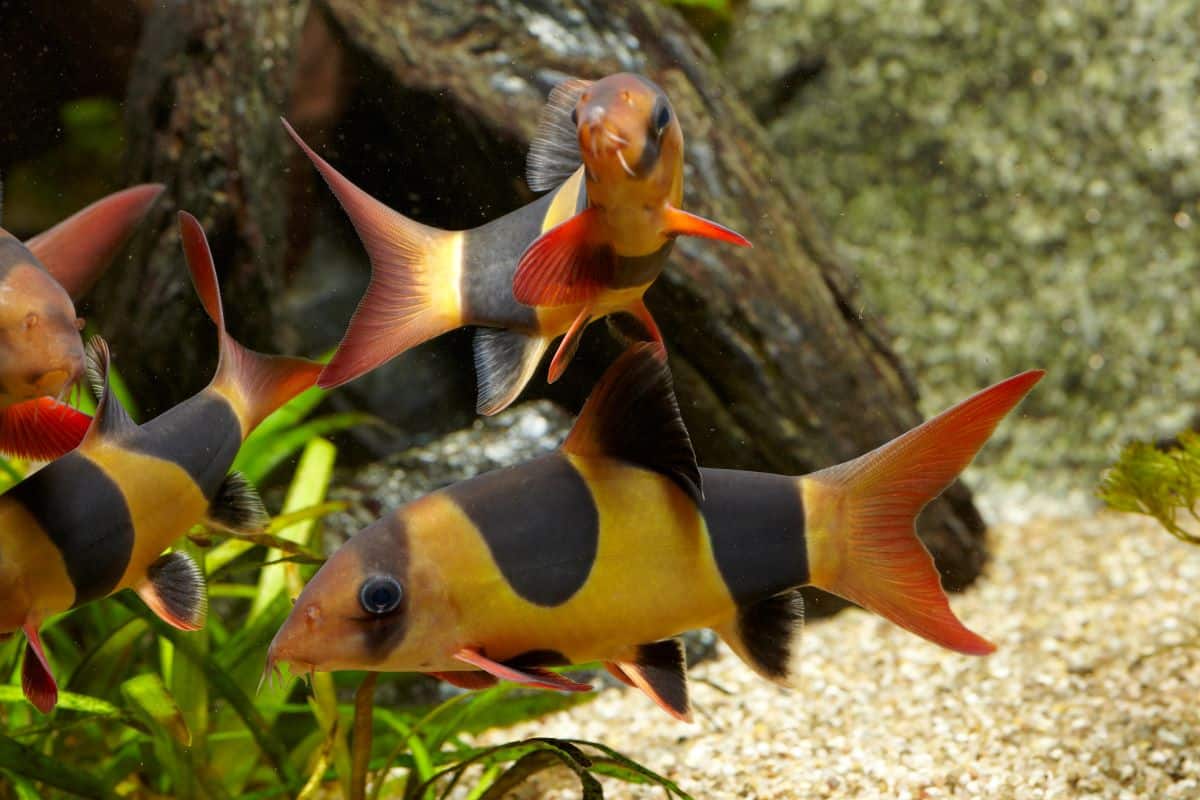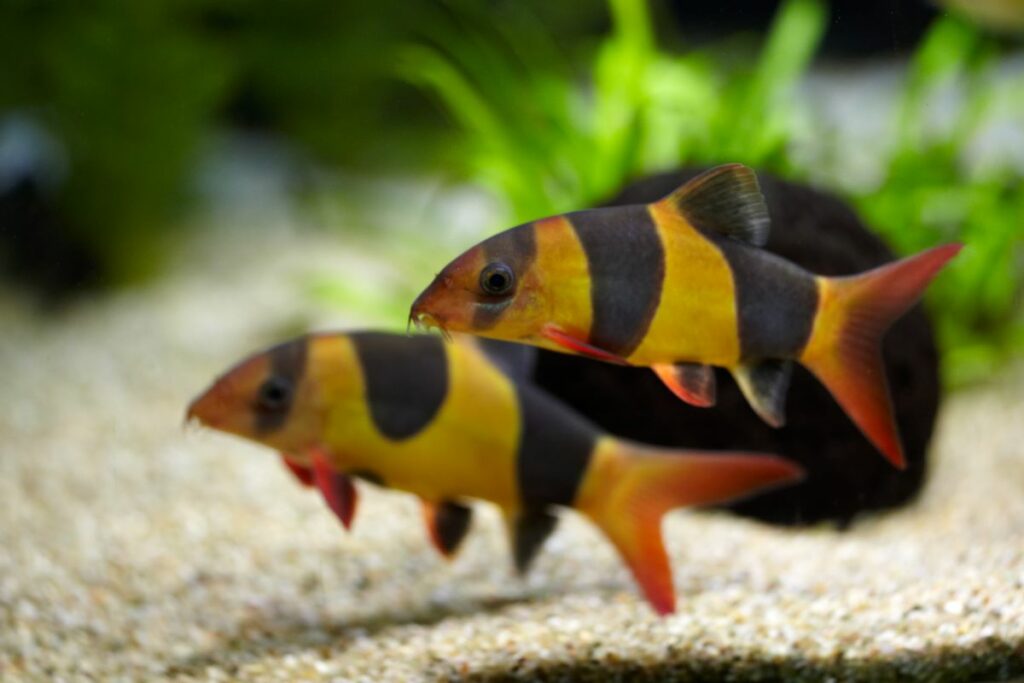the essentials in brief
Loaches in an aquarium will typically eat live or frozen foods such as insect larvae.
The size of loaches can vary by species, but many species grow to around 10 to 20 cm in length. Read more here...
There are several types of loaches, including the striped Dojo loach. Everything else here...
Loaches are a fascinating group of freshwater fish that impress with their diverse shapes, colors and behaviors.
In this blog post you will find out everything you need to know about loaches in the aquarium: What types are there, how can you keep and care for them properly, how can you feed and reproduce them and what are their special features?
The different types of loaches

There are more than 1000 species of loaches in over 100 genera. you are vor especially widespread in Asia, but also occur in Europe and Africa. Most loaches live in flowing water such as streams or rivers.
But there are also some types that in standing water live like lakes or ponds. The size of the loaches ranges from a few centimeters to a length of more than a meter.
Their appearance is also diverse: they can have different colors and patterns, from plain to colorful, striped or spotted.
The most popular and commonly kept loaches in aquariums include the following species:
The clown loach
The black loach (Chromobotia macracanthus) is one of the largest and most striking species of loach. It can grow up to 30 cm long. Its body is orange with three broad black transverse bands.
It is a very swimming species that gets along very well with other fish. Otherwise he can become stressed and aggressive, which is why he needs it lots of space and hiding places.
The loach is an omnivore that particularly likes to eat snails.
The mud whipper
The mud whip (Botia lohachata) is a smaller species of loach. It grows up to 15 cm long. Their body is silver-gray with dark horizontal stripes that look like a web.
It is very lively and curious and likes life in groups. He needs a lot of space and places to hide, otherwise he will become shy and fearful.
It is a matter of an omnivore, who eats both plant and animal food.
The Siamese sucking loach
The Siamese sucking loach (Gyrinocheilus aymonieri) is a special type of loach that can grow up to 25 cm long. She has an elongated body. Their base color is yellowish or brownish with dark spots or streaks.
It has a large suction mouth for holding on to stones or glass panes. It is a very active and robust fish that can also be kept in harder water.
Er feeds mainly on algae, but also accepts green fodder.
The correct keeping and care of loaches
Loaches are undemanding fish, if you offer them the right conditions. Since they are sociable and social, they should be kept in a group of at least five animals.
The aquarium should at least 100 liters capacity and be equipped with fine sand or gravel as a substrate as well as stones, roots or caves as places to retreat.
Note: Loaches are very sensitive to nitrite and ammonia in the water. That's why you should test the water regularly and change some of it. You should also make sure that the aquarium is well covered, as loaches sometimes try to jump out of the water.
The water temperature should be between 20 and 30 degrees Celsius, depending on the species. The pH should be between 6 and 7 and the water hardness should be between 2 and 20 degrees dH.
Loaches should regular and varied be fed with plant and animal ingredients.
Proper feeding of loaches
The loach is an omnivore that can eat both plant and animal food. They have a big appetite and love to dig up the ground to feed.
Therefore should small portions of food several times a day are offered that can be consumed within a few minutes. Too much food can lead to water pollution and digestive problems.
Tip: Some species of loach have a preference for snails and can effectively remove them from the aquarium. If you want to treat your loaches to snails every now and then as a treat, you can breed them in a separate tank or buy them from a specialist store.
Various types of dry, frozen or live food such as flake food, tablet food, mosquito larvae, Tubifex or Artemia are suitable as food.
Occasionally can too fresh vegetables such as cucumbers, zucchini or peppers are offered.

The multiplication of loaches
Breeding loaches in the aquarium is not easy, but it is not impossible either. Most loach species are segregated sex, meaning there are males and females.
However, the gender differences are often difficult to recognize. As a rule, the females are slightly larger and fuller than the males, and the coloring of the males is often more intense.
Loaches are ready to spawn, when they have reached a certain size, which varies depending on the species.
To encourage the loaches to spawn, the following measures can be taken:
- Increase the water temperature by a few degrees
- Reduce the water hardness by adding distilled water or peat
- Use a stronger pump or an additional filter to increase the flow in the aquarium
- The loaches are fed with protein-rich live or frozen food
- Offer the loaches suitable spawning places such as fine-leaved plants, moss balls or spawning boxes
The loaches usually spawn in the early morning hourswhen they are ready. The eggs are attached to plants or other objects in the aquarium.
Note: Not all species of loaches can be propagated in the aquarium. Some species require special environmental conditions such as seasonal changes, floods or monsoon rains in order to reproduce. These conditions are difficult to replicate in an aquarium.
The number of eggs varies depending on the species several dozen and several hundred. The parents do not care about their offspring and may even eat them.
For this reason, it is necessary to either transfer the eggs to a separate breeding tank or remove the parents from the aquarium.
Depending on the species, the young fish hatch after a few days or weeks. The very small young fish need fine food such as infusoria, microworms or artemia.
To ensure optimal water quality, they should be implemented regularly.
The peculiarities of loaches
Loaches are not only beautiful and interesting fish, but also very special ones. They have some characteristics and abilities that set them apart from other fish.
Tip: If you want to give your loaches some variety, you can give them different toys in the aquarium, such as rings, balls or mirrors. You can also interact with them by giving them food or petting them.
Here are some examples:
- have loaches an inferior suction mouth. This allows them to hold on to stones or plants or to dig through the ground for food.
- There is under each eye an eye thorn, which can be deployed if the loach feels threatened. It helps to ward off predators or fight rivals.
- Loaches usually have the ability to touch and smell six barbels on the mouth. They can also detect electrical signals from other fish or prey.
- Mud whippersnappers are very intelligent and trainable. You have the ability to adapt to different situations and solve problems. So they are e.g. B. able to get food from containers by tipping over or opening them. They can also communicate with other fish or humans. This is done through sounds or body language.
- The loach is a very curious and playful animal. They enjoy exploring their surroundings and interacting with different objects. This can e.g. B. playing with stones, plants or air bubbles. You can also play with other fish or people. They follow them, nudge them or bring them something.
Loaches are more than just fish
Loaches are a fascinating group of freshwater fish that impress with their diverse shapes, colors and behaviors. They belong to the loach-like family, a superfamily of carp-like that includes over 1000 species in more than 100 genera.
Loaches have a high level of intelligence and often display very curious and playful behavior. They can even make noises by blowing air or grinding their teeth.



